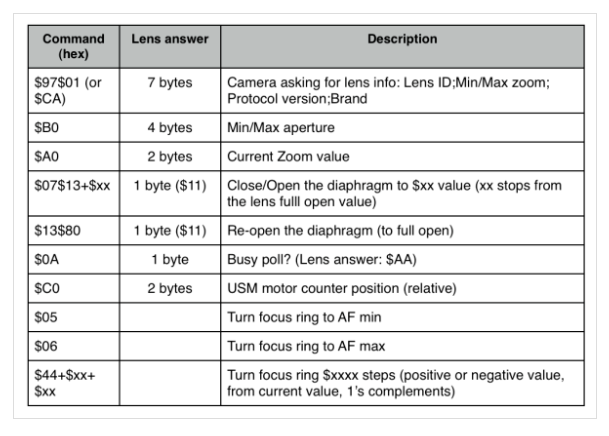-
Posts
6,077 -
Joined
-
Last visited
Content Type
Profiles
Forums
Articles
Everything posted by BTM_Pix
-
Good tip. Was looking in the Setup menu for a different option. Didn't think to hit the screen ! Where does 6.5v equate to on the meter? I've currently got 6.8v and its showing the sort of 80% type of region. Which is suspiciously (or pleasantly) high considering it hasn't been on charge that long. EDIT>> UPDATE Now showing 6.7v and 50% in the time its taken to write the first part of the post.
-
The battery gauge behaviour on this camera just emphasises what a balls up BM have made not having the external power options available from the get go. It appears to go : Full Quite full About half full About a quarter full (showing Red) Off The rate at which it goes from 1-3 is probably reasonably accurate for the expected run time but the step from 3-4 isn't and the almost instant drop from 4-5 (ie Off) is ridiculous. As is the fact that if you switch it back on again, it goes back to 4 for about a minute and then back to 5. And then if you leave it for a few moment, you can do that same thing again. And again. The fact that I wasn't actually taxing the camera at all other than having it sat there while I sent a few Bluetooth messages to it (so there was no variance in power consumption from putting it in and out of record for varying times) is a bit concerning as to how this erratic power indication would work under actual use. I thought the battery gauge behaviour on the original Pocket was random enough but at least that had a percentage indicator to let you know precisely how random it was being. If it behaves like this when it is more or less just sat there then I would be very wary about doing anything critical with this camera once the the battery randometer has gone below half. And before the sock puppets show up and ask, yes I was using the real BM battery and yes I had fully charged the battery out of the box before the camera was switched on.
-
Its the video camera version of "Never Mind The Bollocks". But without the spitting.
-
Its the versatility I'm after rather than it being a real "pocket version" to be honest and I wouldn't baulk if it was the same price. I'm thinking more of stripping it to fit on a small single handed gimbal as an Osmo RAW alternative for one thing. But there have also been some very nice compact setups made for the BMMCC using inexpensive EVFs etc such as the one in this thread here which would give it an edge for handheld shooting. The remote port on the BMCCC is really good for making custom controls and its sad really that the Pocket 4K has dispensed with the LANC port as even a simple start stop if its on a gimbal will require using their app or an as yet unreleased 3rd party Bluetooth LE controller from someone .... With regard to the heat, at least on the BMCCC the battery sits outside the chassis and I've got to say even after just 5 minutes of poking around in the menus of my newly received Pocket 4K earlier it was getting a bit warm inside the grip. From my point of view-and its only a personal preference - if a BMCCC form factor version (not necessarily as small but just the same principle of sensor in a box with no screen but with the ports, external battery etc) had been available then I'd have definitely picked that one over what I've got in front of me. Maybe I'm just a 5" loupe and a next generation compact gimbal away from loving this one
-

Panasonic announcing a full frame camera on Sept. 25???
BTM_Pix replied to Trek of Joy's topic in Cameras
Us -
I think what's being described really (APS-C, MFT mount, integral ND, speedboostable, long battery life) is the JVC LS300 with a RAW option but unfortunately I'm not sure JVC are going to update it any time soon. Funnily enough, I'd like to see BM go the opposite way to some extent and offer an alternative with the Pocket 4K internals inside a form factor more akin to the Micro Cinema and Micro Studio cameras.
-

I am leaving Vimeo over their scandalous DMCA policy
BTM_Pix replied to Andrew Reid's topic in Cameras
A good few years ago when wedding and videographers were trying to stay within the law when selling DVDs that had copyrighted music in them, the PRS came up with a very pragmatic solution called a Limited Manufacture license. The LM license lets you license the use any piece of recorded music with a sliding scale of costs depending on how many physical copies that you are going to sell, so if you are doing a wedding video that will only have 3 copies produced then it will be about £7 to cover the license and if you are doing a school play that you sell 100 copies of it will be about £40 etc Basically, by recognising that not everyone is making a feature film but still wants to be able to use some music, they have made a system that is simple enough, appropriate enough and cost effective enough that people will choose to use it and stay legal. It also means, of course, that the artists still get paid something rather than the nothing they would receive otherwise. One interesting part of the license is the 'Amateur Societies' clause which also grants the license for the following : Recordings made for playing and showing only as part of the practicing, participating and competing in recognised amateur society activities, including: musical gymnastics, horse dressage, synchronized swimming, amateur dramatics and amateur film making. Obviously, this means that if you made a film that you would normally put on Vimeo but instead made a DVD of it that you showed as part of a film making club then you would be covered. Where this LM license scheme needs to catch up is in making a version of it that recognises that places such as Vimeo are the modern de facto version of an amateur film making society. Or at least they could be. If Vimeo had a specific walled off section that was designated as an amateur film making society only (with no links, no product reviews, no ads etc) then I do think there is something there that could be negotiated. And if not Vimeo, a new dedicated Amateur Film Making Society site could be a way forward. https://www.prsformusic.com/licences/releasing-music-products/limited-manufacture -

Panasonic announcing a full frame camera on Sept. 25???
BTM_Pix replied to Trek of Joy's topic in Cameras
All Panasonic were waiting for was to release it with their own name on it. They have had a FF mirrorless 4K camera with 10 bit 4:2:2 HDMI output hiding in plain sight for 3 years and 4 days. -
-
I've seen some very interesting stuff on YouTube with the FS5 and ProResRAW. I don't know whether Atomos would do it but the AtomX expansion port would be a great way to for them to have an add on to add SDI and ProResRAW to the Ninja V. A used FS5 with that would probably be $3.5K ish which is a lot of bang for the buck.
-
I think the really impatient ones will be cutting the mains cable in half then attaching a barrel connector to the harvested side so they can attach it to the ubiquitous £10 Small Rig Sony F battery plate
-
I think Brian Lara will be looking anxiously over his shoulder before long.
-
A poster on the BM and BMC forums has a useful sheet for different batteries based on user experiences reported in their threads. https://docs.google.com/spreadsheets/d/1aAmZ3u4ZdYQznj_cTCtGcMxsZxT_l2JgmBVj0ADWl1s/edit#gid=0 BM have shot themselves in the foot a bit by not getting the power accessories in place when they shipped the camera. The list their own battery for £35 and, whilst that is still a lot more than other 3rd party batteries, I think that would be by far the best way to go as at least you know you are using the same battery they design for and test with but I can't actually see it at any of their UK dealers. Similarly, it doesn't help that the official cable pack that would enable it be powered externally doesn't seem available anywhere either.
-
What brand are the 3rd party batteries? Sounds like a job for a strip of velcro and our old friend expoxy
-
Yeah, the reports I'd read related to it doing with 3rd party batteries but then also with some genuine Canon batteries but they have subsequently turned out to be very convincing fake Canon batteries ! I'm sure CVP will be able to sort it for you.
-
I'm wondering which version of the battery compartment I'm going to get when the courier finally shows up with mine now. One of the ones where you can't get the battery out or the one where it wants to get out all on its own.
-
And then the Sony guy being interviewed after it basically says "Yeah, we've got an 8K camera but you're not getting it until we feel like it"
-
I was watching the BBC's tech show Click last night and it included a feature about Photokina. Look what happens when someone speaks to a manufacturer as a journalist rather than an affiliate link peddler and look how fucking shocked and wrong footed the guy from Canon is by it !! (its at 4:07 if it doesn't auto start there)
-

Canon EOS R first impressions - INSANE split personality camera
BTM_Pix replied to Andrew Reid's topic in Cameras
This is potentially something that 3rd party adapter manufacturers could address. There are a fair number of people who have done projects for various reasons where they have used a micro controller to talk directly to Canon lenses or to use them as interpreters/filters between the body and the lens. There are two ways to do it, the first of which is to attach directly to the pins inside the lens (which means you'd have to do it for every lens) but the neater way (at least for experimental purposes) has been to use a cheap £10 AF macro adapter and wire to that so it sits between the body and the lens. The basic premise is that the micro controller can send its own messages to the lens, pass the ones on to and from the body as is or modify them to what they need to do. The one that would be interesting for this scenario of course is when the camera makes the request for the lens info, the reply from the controller could be "An EF-S lens you say? No not me guvnor, I'm a full frame one I am. Known for it in fact" and pass it the details of an EF lens or third party APS-C lens of the same spec. Obviously the current snag in using the macro adapter is that it is for experimental purposes (or for building macro focus stacking apps) as it obviously makes the lens a macro one. However, for the EOS-R, when 3rd parties come up with their own adapter (which won't be long) then they could build this in quite easily and cheaply. In the meantime, it would be an interesting experiment with the macro adapter as is just to see if the EOS-R could be persuaded it didn't have an EF-S lens attached. The other experiment, which is a bit left field, is to try the equivalent of an old fashioned disc swap hack. If you put the camera in record with an EF lens at one of the forbidden formats, what happens when you remove the lens with it still running? If it doesn't stop the recording, what does it then do if you attach an EF-S lens? Possibly one with the contacts taped over -

DJI X5R (4K RAW) + Osmo + Inspire 1... anybody else with the same idea?
BTM_Pix replied to Oliver Daniel's topic in Cameras
Turning a blind eye to the "But its not 4K" elephant in the room for a moment , I'm wondering whether a roll your own solution with a used BMMCC might be an option? There have been a ton of cheap compact gimbals released in the past couple of years that can handle the weight of it and once you have it balanced you can just leave it permanently on to achieve that same level of immediacy of getting it out of the bag. The expansion port has a composite out on it that you can use with FPV transmitters but also with a £15 EasyCap interface to monitor on an android phone. The expansion port also allows pretty straightforward ways to do remote control and focus as well. As I say, its obviously not 4K but if you want the same philosophy as the Osmo without the proprietary stuff then its not a bad alternative and a bit cheaper. I think the Ronin S as used in this video is a bit overkill and would make it more expensive but still, its a nice illustration of the possibilities. But its not 4K -
@Ed_David has started a thread about the Nucleus M two topics down from this, so might be a place to ask him directly. I'm pretty sure I remember @DBounce getting the Tilta as well but I could be mistaken.
-
There is no gaffa tape or exposed wiring so it can't be anything to do with me
-
From his notes on YouTube, he was using a 5DMk3 so its going to be tough from an HD source with the radical amount of correction the clip needed for the final clip to not suffer. The other example that @Emanuel posted is from a 4K source and does seem to fair better though, again, the shooter was doing some deliberately extreme moves to torture test it so I would suspect that in more realistic usage it would hold up even better as it was cutting into the image less. Difficult to know with these things though without real hands on.
-
Indeed. Looking at this review, it has comments from SteadXP themselves regarding shutter speed. "...we recommend around 1/200 sec shutter speeds, but experienced user can go as low as 1/100. It's a small limitation with very high contrast scenes, but you can get perfect cinematic look in a lot of situations!" Mmm.... https://www.engadget.com/2018/01/24/steadxp-s-dslr-stabilizer-impressions/









